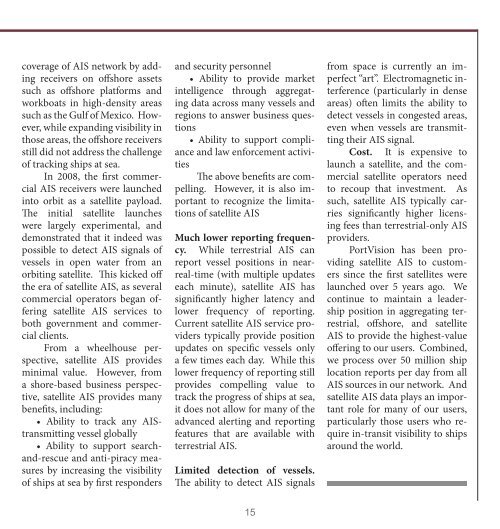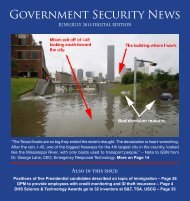Government Security News
You also want an ePaper? Increase the reach of your titles
YUMPU automatically turns print PDFs into web optimized ePapers that Google loves.
coverage of AIS network by adding<br />
receivers on offshore assets<br />
such as offshore platforms and<br />
workboats in high-density areas<br />
such as the Gulf of Mexico. However,<br />
while expanding visibility in<br />
those areas, the offshore receivers<br />
still did not address the challenge<br />
of tracking ships at sea.<br />
In 2008, the first commercial<br />
AIS receivers were launched<br />
into orbit as a satellite payload.<br />
The initial satellite launches<br />
were largely experimental, and<br />
demonstrated that it indeed was<br />
possible to detect AIS signals of<br />
vessels in open water from an<br />
orbiting satellite. This kicked off<br />
the era of satellite AIS, as several<br />
commercial operators began offering<br />
satellite AIS services to<br />
both government and commercial<br />
clients.<br />
From a wheelhouse perspective,<br />
satellite AIS provides<br />
minimal value. However, from<br />
a shore-based business perspective,<br />
satellite AIS provides many<br />
benefits, including:<br />
• Ability to track any AIStransmitting<br />
vessel globally<br />
• Ability to support searchand-rescue<br />
and anti-piracy measures<br />
by increasing the visibility<br />
of ships at sea by first responders<br />
and security personnel<br />
• Ability to provide market<br />
intelligence through aggregating<br />
data across many vessels and<br />
regions to answer business questions<br />
• Ability to support compliance<br />
and law enforcement activities<br />
The above benefits are compelling.<br />
However, it is also important<br />
to recognize the limitations<br />
of satellite AIS<br />
Much lower reporting frequency.<br />
While terrestrial AIS can<br />
report vessel positions in nearreal-time<br />
(with multiple updates<br />
each minute), satellite AIS has<br />
significantly higher latency and<br />
lower frequency of reporting.<br />
Current satellite AIS service providers<br />
typically provide position<br />
updates on specific vessels only<br />
a few times each day. While this<br />
lower frequency of reporting still<br />
provides compelling value to<br />
track the progress of ships at sea,<br />
it does not allow for many of the<br />
advanced alerting and reporting<br />
features that are available with<br />
terrestrial AIS.<br />
Limited detection of vessels.<br />
The ability to detect AIS signals<br />
from space is currently an imperfect<br />
“art”. Electromagnetic interference<br />
(particularly in dense<br />
areas) often limits the ability to<br />
detect vessels in congested areas,<br />
even when vessels are transmitting<br />
their AIS signal.<br />
Cost. It is expensive to<br />
launch a satellite, and the commercial<br />
satellite operators need<br />
to recoup that investment. As<br />
such, satellite AIS typically carries<br />
significantly higher licensing<br />
fees than terrestrial-only AIS<br />
providers.<br />
PortVision has been providing<br />
satellite AIS to customers<br />
since the first satellites were<br />
launched over 5 years ago. We<br />
continue to maintain a leadership<br />
position in aggregating terrestrial,<br />
offshore, and satellite<br />
AIS to provide the highest-value<br />
offering to our users. Combined,<br />
we process over 50 million ship<br />
location reports per day from all<br />
AIS sources in our network. And<br />
satellite AIS data plays an important<br />
role for many of our users,<br />
particularly those users who require<br />
in-transit visibility to ships<br />
around the world.<br />
15







